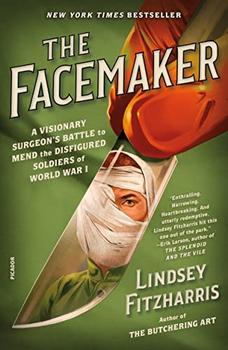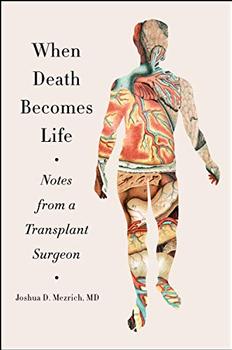Summary | Excerpt | Reviews | Beyond the book | Read-Alikes | Genres & Themes | Author Bio

A Visionary Surgeon's Battle to Mend the Disfigured Soldiers of World War I
by Lindsey FitzharrisThe summer of 1914 saw the beginning of World War I, the bloody conflict known as the "war to end all wars." As the fighting raged on, the number of injured men quickly swelled, and physicians found themselves confronted with wounds and trauma of unprecedented severity and number. Many despaired in the face of this brutality, but some found new inspiration and optimism in their ability to alleviate the suffering of the injured. In The Facemaker, Lindsey Fitzharris shares the history of one such individual: Harold Gillies, a celebrated surgeon and visionary who became one of the pioneers of facial reconstruction. Through the work of Gillies and his team, injured soldiers were given not only new faces but new chances at life. Intriguing, detailed, and often macabre, The Facemaker is a story of war, medicine and art that explores the lasting influence of Gillies' legacy.
Although early attempts at facial reconstruction had been made during the American Civil War, the advancements in weaponry and warfare unveiled during WWI created unique medical challenges. Fitzharris discusses the new military developments that emerged during this conflict — including poisonous gases, long-range weapons, high-velocity shrapnel, flamethrowers, air combat and extended trench warfare — noting that "Europe's military technology had wildly surpassed its medical capabilities." Soldiers sustained injuries more horrific than had previously been seen on the battlefield, but while amputees were readily celebrated as heroes, those with facial disfigurements were often viewed with revulsion.
Harold Gillies sought to change that. Born in New Zealand, Gillies attended school in his home country before traveling to England to study medicine. Following the outbreak of WWI, Gillies was driven by a desire to use his medical talents to help the wounded. He fought for the development of a hospital dedicated solely to the care of soldiers with facial wounds, and in 1917, the Queen's Hospital in Sidcup (located in southeast London) was opened with this specific purpose. Although Gillies was not the only physician to work towards restoring the faces of injured men, he was one of the few to bring together a large team of specialists to assist in the process, increasing the chances of a successful reconstruction process and an as-normal-as-possible life for the patient. In addition to himself, a well-known otolaryngologist, Gillies brought in dentists, radiologists, artists, sculptors and mask-makers; each specialist played a role in not only visually restoring the face of the patient but restoring functionality, thus conferring a better quality of life.
Gillies oversaw these specialists while performing countless surgeries. Fitzharris describes Gillies' surgical techniques in detail, and while some specificity helps allow for visualization of the process, the descriptions occasionally become overly complex. The pictures included in the book are of greater benefit, showing several patients before, during and after their surgeries. These images drive home the brilliance of Gillies' efforts as well as the brutality of warfare, and following the stories of the men in the pictures during their time in Gillies' care gives a personal aspect to the account. However, the images of the wounded men are gruesome — as are many of Fitzharris' descriptions — and they may make some readers uncomfortable.
The book concludes by following Gillies' work after the war. Although he continued to perform reconstructive surgeries on injured soldiers as well as others injured in accidents, he also began to perform cosmetic surgeries on civilians. These included procedures that are commonplace today in the field of plastic surgery — such as pinning back protruding ears and reshaping noses and chins — and while many accused him of encouraging his patients' vanity, Gillies saw his work as a way to bring people happiness. He continued to develop groundbreaking surgical techniques and established the first professional body for plastic surgeons — the British Association of Plastic Surgeons — of which he became the first elected president. Plastic surgery for both cosmetic and reconstructive purposes has continued to advance since Gillies' era and to change the lives of individuals around the world.
Equally tragic and inspirational, detailed and thoroughly intriguing, The Facemaker brilliantly recounts the innovative efforts of Harold Gillies as he not only restored the faces of men injured on the battlefields but also laid the foundation for modern plastic surgery. Those interested in history, medicine and World War I will find plenty to love in Fitzharris' book if they can stomach the graphic descriptions and images.
![]() This review was originally published in The BookBrowse Review in August 2022, and has been updated for the
June 2023 edition.
Click here to go to this issue.
This review was originally published in The BookBrowse Review in August 2022, and has been updated for the
June 2023 edition.
Click here to go to this issue.

If you liked The Facemaker, try these:

by Emma Donoghue
Published 2021
In Dublin, 1918, a maternity ward at the height of the Great Flu is a small world of work, risk, death, and unlooked-for love, in "Donoghue's best novel since Room" (Kirkus Reviews).

by Joshua D. Mezrich
Published 2020
A gifted surgeon illuminates one of the most profound, awe-inspiring, and deeply affecting achievements of modern day medicine - the movement of organs between bodies - in this exceptional work of death and life.
Your guide toexceptional books
BookBrowse seeks out and recommends the best in contemporary fiction and nonfiction—books that not only engage and entertain but also deepen our understanding of ourselves and the world around us.